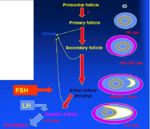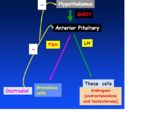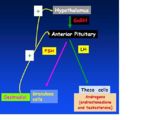Follicles - Anatomy & Physiology
| This article has been peer reviewed but is awaiting expert review. If you would like to help with this, please see more information about expert reviewing. |
Introduction
The follicle is the functional unit of the ovary containing both gametes (Oocyte) and endocrine cells (Granulosa and Theca cells). A female is born with all the primordial follicles it is ever going to have i.e Primordial Follicles do not divide anymore, they either develop further into primary, secondary, and tertiary follicles or they degenerate. Therefore the number of follicles declines with age as follicles develop and degenerate during the oestrus cycle. When the supply of follicles is depleted then reproductive senescence occurs. In humans this phenomenon is known as "The Menopause". Prior to ovulation, oogenesis and hormone production both occur in the follicle. The process of follicular growth is known as Folliculogenesis.
General Structure
- Made up from two cell types; Granulosa cells and Theca cells aranged in two different layers.
- The Granulosa cell layer is the inner cell layer found closest to the oocyte
- The Theca cell layer is the outer cell layer
Follicular Development (Folliculogenesis)
Primordial Follicle
- Smallest and most immature follicle
- One primary oocyte surrounded by a Single layer of squamous cells known as pre-granulosal cells.
- Development from the primordial follicle to the primary follicle is characterized by:
- This development is driven by Gdf9 and BMP15. Knockouts of these genes result in the failure of primordial follicles to develop into primary follicles. These are normally found within the oocyte itself.
Primary Follicle
- Oocyte surrounded by a single layer of follicular cuboidal cells.
- The primary follicle will develop into a secondary follicle.
- Granulosa cells proliferate into multiple layers and at the end of this the oocyte is fully grown.
- Events that characterize this transition are:
- Thecal layer becomes organised into the Theca Interna and the Theca Externa
- Vascularisation of the theca
- If gonadotrophins (LH and FSH) are removed, this transition still takes place.
Secondary Follicles
- The oocyte has developed a thick translucent glycoprotein layer called the Zona Pellucida.
- Oocyte surrounded by two or more layers of follicular cuboidal cells. These cells differentiate into the inner Granulosa cells and outer Theca cells.
- Connective tissue cells surrounding the granulosa cells differentiate to form the layers of theca cells which produce androgens.
- Theca cells produce Androstienedione which is converted to 17β-Oestrodiol (E2) by the Granulosa cell enzyme Aromatase.
- Granulosa cells become responsive to Follicle Stimulating Hormone (FSH) and start producing 17β-Oestrodiol and small amounts of Inhibin and Progesterone.
- Despite the presence of the zona pellucida, the inner granulosa cells are able to communicate with the oocyte through gap junctions.
- Following formation of the theca cells, the primary oocyte reaches full size.
- Granulosa cells secrete fluid, resulting in the formation of a fluid filled space known as the antrum.
Tertiary/Antral Follicles
- The antrum (filled with follicular fluid) is characteristic of antral/tertiary follicles.
- Antral follicles are responsive to gonadotrophins, mainly FSH but LH as well.
- The innermost cells of the Granulosa layer become firmly attached to the Zona Pellucida and are known as the Corona Radiata. The outermost Granulosa cells become attached to the basement membrane surrounding them and become known as the Theca Folliculi.
- Theca cells become organised into Theca Interna and Theca Externa layers.
- The Theca Interna layer cells differentiate into steroidogenic cells producing the Androgen Androsteinedione in response to the Gonadotrophin Luteinising hormone (LH).
- Theca Cell layer becomes vascularised.
Dominant Follicle
- Only a single Dominant follicle forms with each wave of folliculogenesis.
- The folliclular Antrum enlarges due to the Granulosa cells becoming receptive to LH.
- All of the other follicles undergo degeneration.
- Ovulation of the Dominant follicle's Oocyte occurs in response to an LH surge.
Atretic Follicles
- Atresia is the the fate of most of the ovarian follicles as only a small number are ovulated.
- It may occur at any stage of follicular development from primary to tertiary follicle.
- Atretic follicles are characterized by:
- Numerous pyknotic nuclei in the granulosa, absence of mitosis in this layer.
- Disruption of the basal lamina.
- Presence of free floating cells with dark staining, pyknotic nuclei in the antral cavity.
- Presence of clear vacuoles in the oocyte, disruption of the oolemma.
The Follicular Wave
- At the beginning of each cycle, a few primary follicles begin to develop into antral follicles.
- What causes the selection of particular follicles is unknown, but it is thought to be due to the paracrine action of growth factors such as EGF and IGFs.
- Major enlargement of the follicle is not due to the oocyte increasing in size, but down to the gain in follicular fluid secreted by the granulosa cells.
- A further selection process occurs whereby a single follicle (the dominant follicle) is selected for continued development.
- What causes this single follicle to be chosen is unknown.
- For complete follicular development to occur at this stage, LH and FSH are essential. The development of a tertiary follicle cannot happen in the absence of these gonadotrophins.
- The rest of the follicles which had started to enlarge undergo a degenerative process called atresia.
- The dominant follicle enlarges, mainly as a result of its expanding antrum.
- Growth of the dominant follicle is dependent on LH as the granulosa cells acquire LH receptors.
- Ovulation occurs in response to a dramatic increase in LH levels.
- The role of FSH is superceeded by LH in the dominant follicle.
Endocrine Control of Follicular Growth and Steroidogenesis
- Under gonadotrophin stimulation, the Antral follicle starts to grow.
- Initially, FSH acts on granulosa cells to induce synthesis of oestrogens.
- Oestrogen has a paracrine action within the ovary to induce the proliferation of granulosa cells.
- During early-mid follicular phase of the oestrous cycle, plasma oestrogen exerts a negative feedback inhibition on gonadotrophin secretion.
- As a result of this, FSH levels begin to fall.
- The inhibiting effect of oestrogen only occurs whilst plasma oestrogen is below a certain threshold value.
- During later stages of the follicular phase of the oestrous cycle, one follicle willl become dominant and it becomes the major producer of oestrogen.
- Under the influence of oestrogen, granulosa cells which were previously unresponsive to LH, acquire LH-receptors and become responsive to LH.
- The plasma concentration of oestrogen starts to rise.
- When plasma concentrations rise above the threshold value, it acts to enhance gonadotrophin secretion by positive feedback.
- The high level of oestrogen causes the LH surge that leads to ovulation.
| Follicles - Anatomy & Physiology Learning Resources | |
|---|---|
 Selection of relevant PowerPoint tutorials |
Histology of the female reproductive tract |









